|
|
The Aviation Tourist in Boston
by Philip Greenspun, updated February 2019
Site Home : Flying : One Article
|
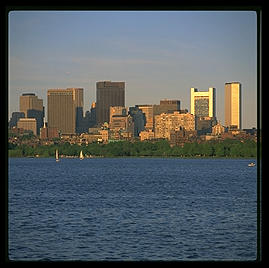 Cold and grey in the winter, hot and hazy in the summer, windy and gusty
in the spring and fall as the weather systems move through, New England
would seem to be a poor choice of destination for the aviation tourist.
Nonetheless, if business calls you to Boston and the weather gods smile
it is possible to indulge almost any aviation interest within a
45-minute drive of downtown.
Cold and grey in the winter, hot and hazy in the summer, windy and gusty
in the spring and fall as the weather systems move through, New England
would seem to be a poor choice of destination for the aviation tourist.
Nonetheless, if business calls you to Boston and the weather gods smile
it is possible to indulge almost any aviation interest within a
45-minute drive of downtown.
Here are the things that you can do within a 30-kilometer radius of the
city center:
- take aerobatics instruction from a former U.S. military fighter pilot
- learn to fly a helicopter (world's lowest prices on the Robinson R44)
- rent an airplane and fly out to the beach-island playgrounds of the
rich and famous
- take off from a non-towered field and, after flying for 20 minutes,
land at Logan Airport, the world's 32nd busiest, in the heart of Class B
airspace
- work toward the FAA certificate of your choice, from Private through
Airline Transport Pilot (ATP), at the flight school of your choice
The Airspace and the Air
Logan Airport sticks out into Boston Harbor, more or less from downtown.
Its Class B airspace thus overlies the city center. Roughly 14 n.m. out
is a ring of towered airports that serve general aviation and whose
Class D airspaces are underneath Logan's Class B. These are Beverly
(KBVY), Bedford (Hanscom, KBED), and Norwood (KOWD). At roughly 20
n.m. out there is another ring of airports, including the towered field
of Lawrence (KLWM) and a bunch of non-towered airports such as
Marshfield, Plymouth, and Taunton.
You'll want the Boston VFR Terminal Area chart, available at any flight
school, before venturing out. Boston Approach controls the low altitude
airspace near the city and they tend to be fairly busy during the
daylight hours, often too busy to provide flight following. Very seldom
will they clear you through Class B airspace; you always always have to
go around and underneath.
Despite the fact that Eastern Massachusetts is, by western North
American standards, virtually flat, surface winds in excess of 15 knots
usually translate into a very bumpy ride in the air. One way to escape
the turbulence is by climbing. The air is usually smooth by 7500' MSL
but sometimes you'll need to go as high as 9500' or 10,500' to be out of
the bumps. Another way out is to head for the beach. Very seldom will
you be more than a 10-minute ride from the ocean. Once you have the
airplane a few hundred meters offshore the air is almost always smooth.
Flying 1500' above the waves is a great way to see many of the most
attractive houses in New England and more than likely following the
coast won't add more than 15 minutes to the total flying time in
reaching your destination.
Hanscom Field, Bedford, Massachusetts
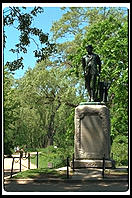 Hanscom Field in Bedford (KBED) will very likely be the most
convenient base for your aviation tourism. If you're bringing your
own aircraft, there are three FBOs. None are inexpensive,
unfortunately,
but Rectrix
will likely provide the warmest welcome.
Hanscom Field in Bedford (KBED) will very likely be the most
convenient base for your aviation tourism. If you're bringing your
own aircraft, there are three FBOs. None are inexpensive,
unfortunately,
but Rectrix
will likely provide the warmest welcome.
Hanscom is accessible from downtown
Boston via public transit (Red Line on the subway to Alewife, then MBTA
Bus 76) and is close to the high-tech companies on Route 128, also known
as Interstate 95, the ring highway surrounding Boston. The closest
hotel to the field is the Sheraton Lexington. If you're coming from the
New York area you can even fly directly into Bedford on U.S. Airways or
Pan Am.
Hanscom has a 7000' main runway with an instrument landing system
(ILS) in both directions and a 5000' crosswind runway. The tower has
radar and, aside from the high level of corporate jet and student
traffic, Hanscom is a very easy place to operate. East Coast Aero Club
(www.eastcoastaeroclub.com;
no membership fee required) offers an assortment of well-maintained
low-wing airplanes at low prices and a diversity of high-time
instructors who are dedicated to teaching (and/or have rich wives). I
was a student at ECAC starting in 2001 and have been teaching there
since 2005. My specialties are the Robinson R44 helicopter and
instrument airplane instruction in the Cirrus SR20. ECAC also offers
aerobatics instruction with Marc Nathanson, a former fighter pilot,
and Bill Witzig, a former USMC test pilot and current aerobatics competitor.
East Coast Aero Club is the only facility in Bedford with helicopter
instruction using the four-seat Robinson R-44 at the world's lowest rates.
A One-hour Sightseeing Flight
For a good introduction to coastal New England scenery, depart Bedford
to the northeast, towards Lawrence (KLWM), and follow the Merrimack out
towards the sea. If you climb to 2900' you'll be above Lawrence's Class
D airspace and below Boston's Class B. Once you reach the ocean, drop
down to 1500' and head south along the beach. After about 5 minutes
you'll reach Cape Ann and a beautiful view of the Crane Mansion. Turn
left to stay off-shore and follow the outline of Cape Ann. You'll pass
over Rockport, home of cheap lobster and cheaper seascape oil
paintings. You'll pass over Gloucester Harbor, home port of the
swordfishing boat Andrew Gail, whose unfortunate fate was
chronicled in the book The Perfect Storm. Begin to head
north across Cape Ann when you're approaching Beverly airport's Class D
airspace, then head back to Bedford for landing.
If you want to turn this into a day trip, land at the Plum Island
airport (2B2), in and among the dunes, if you don't mind a 2100'
runway. Bob Lobster, a classic New England seafood shack (with fully
up-to-date prices!), is an easy walk east from aircraft parking.
Cape Cod and the Islands
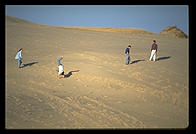 The quintessential Boston getaway is to Cape Cod and the islands of
Martha's Vineyard and Nantucket. If Cape Cod is your destination you
can save some air time by renting a plane on the South Shore, e.g.,
Marshfield or Plymouth . If you start from Bedford you'll spend your
first 20 minutes working your way southeast around the Boston Class B
airspace. You'll reach the coast near Marshfield (3B2; see below) and
proceed south along the beach. Keep going all the way around the
shoreline and land at the Provincetown airport (KPVC; 3500' runway with
ILS and VASI/PAPI). You can walk right into the dunes of the National
Seashore, a beach run by the U.S. National Park Service, or take a taxi
into "P-town", which has all the Victorian bed and breakfasts, fine
restaurants, and lively parties that you'd expect from the gay/lesbian
capital of New England.
The quintessential Boston getaway is to Cape Cod and the islands of
Martha's Vineyard and Nantucket. If Cape Cod is your destination you
can save some air time by renting a plane on the South Shore, e.g.,
Marshfield or Plymouth . If you start from Bedford you'll spend your
first 20 minutes working your way southeast around the Boston Class B
airspace. You'll reach the coast near Marshfield (3B2; see below) and
proceed south along the beach. Keep going all the way around the
shoreline and land at the Provincetown airport (KPVC; 3500' runway with
ILS and VASI/PAPI). You can walk right into the dunes of the National
Seashore, a beach run by the U.S. National Park Service, or take a taxi
into "P-town", which has all the Victorian bed and breakfasts, fine
restaurants, and lively parties that you'd expect from the gay/lesbian
capital of New England.
A more conventional alternative is Chatham. Most of Cape Cod's "towns"
aren't actually towns. Chatham is an exception, with a walkable main street. You can land at
KCQX, which has a
3000' runway that can feel a little less comfortable than
Provincetown's due to being embedded in a forest. The lowest
instrument approach gets you down only to about 550' above the
runway. The airport also has a popular restaurant where families congregate on weekends (photos). If you're not arriving by Gulfstream, I
recommend Pleasant Bay
Village, a motel-style complex with beautiful Japanese gardens,
complete with koi
(my photos from a
summer 2014 stay).
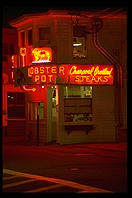 Depart Provincetown Airport and head for the open water just to the
northeast. Look for whale-watching boats because they tend to
congregate around the whales. There aren't too many animals for which
the view from an airplane 500' above the surface is interesting, but
humpback, minke, fin, and right whales are certainly among them. When
you're done with whale watching, fly south along the Atlantic Ocean beaches, the east coast of Cape
Cod, and hold your heading over a 15-mile gap of water that separates
the Cape from the historic whaling island of Nantucket (KACK; 6000'
runway with ILS and VASI; control tower). Nantucket was one of the
largest and wealthiest towns in New England until the discovery of
petroleum took the wind out of the sails of the whaling business.
Consequently a 20-minute walk through the cobblestone streets of
downtown Nantucket will take you past dozens of interesting 18th- and
19-century buildings. If you're around in April, be sure to check out
the Daffodil
Festival, complete with antique car parade, dog parade, and three
million daffodils blooming. For bicycle rentals, contact Nantucket Bike Shop,
which will deliver bicycles to the airport or a nearby hotel, such as
the Nantucket Inn, adjacent
to the airport and famous for Sunday brunch (probably not the best
place on the island to stay).
See my 2014
photos, which includes quiet Madaket Beach, and also
www.nantucket.net for more
information on this island.
Depart Provincetown Airport and head for the open water just to the
northeast. Look for whale-watching boats because they tend to
congregate around the whales. There aren't too many animals for which
the view from an airplane 500' above the surface is interesting, but
humpback, minke, fin, and right whales are certainly among them. When
you're done with whale watching, fly south along the Atlantic Ocean beaches, the east coast of Cape
Cod, and hold your heading over a 15-mile gap of water that separates
the Cape from the historic whaling island of Nantucket (KACK; 6000'
runway with ILS and VASI; control tower). Nantucket was one of the
largest and wealthiest towns in New England until the discovery of
petroleum took the wind out of the sails of the whaling business.
Consequently a 20-minute walk through the cobblestone streets of
downtown Nantucket will take you past dozens of interesting 18th- and
19-century buildings. If you're around in April, be sure to check out
the Daffodil
Festival, complete with antique car parade, dog parade, and three
million daffodils blooming. For bicycle rentals, contact Nantucket Bike Shop,
which will deliver bicycles to the airport or a nearby hotel, such as
the Nantucket Inn, adjacent
to the airport and famous for Sunday brunch (probably not the best
place on the island to stay).
See my 2014
photos, which includes quiet Madaket Beach, and also
www.nantucket.net for more
information on this island.
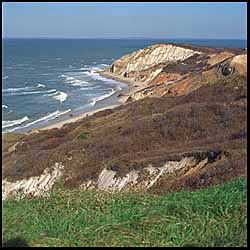 Martha's Vineyard is much larger than Nantucket and the industrial
whaling heritage is not as overwhelming. The big airport (KMVY) has a
control tower, an ILS, a 5500' paved runway, a good on-field restaurant
(breakfast and lunch only) in the fancy new terminal, public transit
service, and high prices for overnight parking. The small airport (1B2)
is Katama Airpark, which includes three grass runways, one of which at
4000' is claimed to be the United States's longest. The grass is quite
firm and the airport is regularly visited by tricycle-gear aircraft,
including light twins. The Katama airport has a restaurant on the field
and is just a short walk from one of the handful of public beaches on
Martha's Vineyard.
Martha's Vineyard is much larger than Nantucket and the industrial
whaling heritage is not as overwhelming. The big airport (KMVY) has a
control tower, an ILS, a 5500' paved runway, a good on-field restaurant
(breakfast and lunch only) in the fancy new terminal, public transit
service, and high prices for overnight parking. The small airport (1B2)
is Katama Airpark, which includes three grass runways, one of which at
4000' is claimed to be the United States's longest. The grass is quite
firm and the airport is regularly visited by tricycle-gear aircraft,
including light twins. The Katama airport has a restaurant on the field
and is just a short walk from one of the handful of public beaches on
Martha's Vineyard.
Nantucket and Martha's Vineyard get pretty crazy during the summer
tourist season and summer weekends are beyond crazy. To escape the
crowds consider a visit to tiny Block Island (KBID, 2500' runway with
VASI/PAPI). Block Island offers similar geography and scenery to its
big brothers but it isn't as large or clogged with Range Rovers and
celebrities.
Bedford-Ptown-Nantucket-Vineyard-Bedford can be flown in about 4 hours
of Hobbs time. See http://www.photo.net/us/ne/cape-cod
for more of the author's photos and advice on Cape Cod and the islands.
Very Big Modern Art and Very Small Airplanes
Western Massachusetts is home to a 3000'-high section of the Appalachian
Mountains, a depressed old mill economy, the Boston Symphony Orchestra
(summer only) and a few important art museums. A good base for
operations is Harriman and West Airport (KAQW) in North Adams. About a
one-hour flight from the Boston area, this uncontrolled field has a
4200' runway, a soaring club (www.mohawksoaring.org), and is
just a short taxi ride from three art museums: Clark Art Institute,
Williams College Museum of Art, and Massachusetts Museum of Contemporary
Art (Mass MOCA). Clark (www.clarkart.edu) has the best
collection, including an extensive assortment of Impressionist works.
Mass MOCA (www.massmoca.org)
offers some of the largest indoor art spaces in the United States and is
home to a seasonally refreshed show of massive works of installation
art. Mass MOCA resides in a 19th-century mill complex that was most
recently used by Sprague Electric to produce capacitors and other
electronic components. An infusion of $22 million in taxpayer funds
turned the old buildings into a destination for art lovers from all over
the East Coast. The project was supposed to provide jobs for locals but
most of the people hired seem to be black-clad New Yorkers. None of the
working-class families that I met in North Adams had visited Mass MOCA.
Even Bigger Art
A little over one hour from Bedford is the 12,000' runway at Stewart
International (KSWF), just north of West Point on the Hudson
River. This airport is the home of C5 cargo planes, first-rate FBOs,
and is convenient to two great art destinations: Storm King Art Center, the
nation's leading sculpture park, and Dia:Beacon, the nation's largest
museum for contemporary art.
Aviation Museum
The only real aviation museum in New England is at KBDL, a very
GA-friendly airport about a 30-minute flight from Boston. The New England Air Museum unfortunately
does not have ramp parking, but Signature at KBDL will be happy to
lend you a beautiful crew car for the 3-minute drive.
Helicopter Lessons
You can take helicopter lessons at Bedford, Lawrence, or Norwood. For
Bedford, see the previous description
of East Coast Aero
Club. A fun stop in the helicopter is the Plum Island airport (see
above) for lobster.
A fun day trip in the helicopter is to fly down to Manhattan, circle
the Statue of Liberty, and land at the Downtown/Wall Street helipad
for lunch (not too much more expensive than parking a car in
Manhattan). About four hours of round-trip flight time in a Robinson
R44.
Running with the Big Dogs
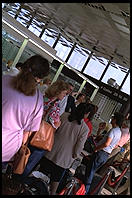 If you want to practice your radio communications skills and get some
beautiful views of downtown Boston there is no better trip than going
into Logan Airport (KBOS). If you avoid peak times such as weekday
afternoons you'll probably get a very pleasant reception. It will also
help if you study the ground diagram before departing and have that
diagram on your kneeboard. Start by listening to the ATIS and then
calling Boston Approach with your position and "Landing with [ATIS
code]". They generally have two runways in use, one for the
heavy airplanes and one for commuter flights. In many ways landing at
Logan is easier than at the busier general aviation airports. There is
no pattern at Logan. Pursuant to FAR 91 Appendix D, section 4, no
solo student pilot operations are permitted at Logan. You won't be
asked to identify and follow some other airplane "about to turn base";
you'll be vectored until you're lined up with the runway and then
cleared to land.
If you want to practice your radio communications skills and get some
beautiful views of downtown Boston there is no better trip than going
into Logan Airport (KBOS). If you avoid peak times such as weekday
afternoons you'll probably get a very pleasant reception. It will also
help if you study the ground diagram before departing and have that
diagram on your kneeboard. Start by listening to the ATIS and then
calling Boston Approach with your position and "Landing with [ATIS
code]". They generally have two runways in use, one for the
heavy airplanes and one for commuter flights. In many ways landing at
Logan is easier than at the busier general aviation airports. There is
no pattern at Logan. Pursuant to FAR 91 Appendix D, section 4, no
solo student pilot operations are permitted at Logan. You won't be
asked to identify and follow some other airplane "about to turn base";
you'll be vectored until you're lined up with the runway and then
cleared to land.
If you touch-and-go you might get away with paying only a $27 landing
fee. Otherwise you'll fall into the hands of the only FBO at Logan:
Signature Flight Support. Without fuel, a one-hour stop here will
cost approximately $225. The Signature folks are helpful and will
shuttle you to the main terminals or airport hotels in their courtesy
van.
Departing Logan is a breeze. Ask for progressive taxi instructions and
directions to a reasonable place to run up. Your biggest risk at an
airport like this is a runway incursion or finding yourself
on the wrong taxiway, nose-to-nose with a 747. Don't be afraid of
sounding amateurish. Remember that this is an international airport.
The pilots of the 747 might never have been to Logan before either.
Boston: Up Close and Personal
If you are familiar with the landmarks of MIT and Back Bay, you can fly
down the Charles River into very nearly the heart of Boston. Here's how
it works, according to my friend Gary:
My procedure is to call Boston approach (124.4) from the vicinity of the
intersection of Rt. 128 and the Mass. Pike at 2000'. "Request transit
Class Bravo for City Tour [that's the local term for it], Charles River
to Back Bay, then return westbound." Usually they'll assign a squawk
code and hand you off to Boston tower or Boston skyway (the helicopter
controller, 124.725). Sometimes they'll just suggest that you call the
tower or skyway with the request.
I generally fly down the river until abeam the Prudential or Hancock
building (except when they only clear me as far as Mass. Ave.), then
turn around to the left over MIT and Harvard.
An anomaly today was that skyway cleared me into Class B at 1000'. I
had to tell them that that would be too low for required terrain
clearance. I requested 1200' instead, and they came back with 1500'
after coordinating with TRACON. Remember to keep 2000' laterally from
the tall buildings.
None of this works during Boston Red Sox games. Under the general
post-9/11 principle that only one American business can be functioning
at a time, aviation within downtown Boston, aside from scheduled
airlines, is shut down from 1 hour prior to a game until 1 hour after
it ends. The NOTAM for sports games (primarily intended to exclude
banner-towing aircraft from competing with in-stadium advertising) has
an exception for aircraft on an ATC clearance, which of course you
would be within the Boston Bravo. However, the FAA controllers within
Boston tower have instructions to exclude airplanes, even ones not
towing banners, from within 3 n.m. of the stadium during the game and
+/- 1 hour.
Up to Maine
New England's only national park is Acadia, on Mt. Desert Island,
connected via a causeway to the Maine coast (http://www.nps.gov/acad/). Acadia
is notable for medium-sized forested mountains meeting the Atlantic
Ocean, red and yellow foliage in the fall, the 45 miles of carriage
roads for bicycling and 115 miles of hiking trails. The airport (KBHB)
is halfway between the towns of Ellsworth (mainland, Walmart, strip
malls) and Bar Harbor (island, village green, cute shops, high prices)
and features a 5200' runway, a crosswind runway, an ILS, and an
excellent FBO. In the summer you can enjoy dog-friendly cruising
on the schooner Rachel B. Jackson (www.rachelbjackson.com).
The coastal route up from Boston takes you past the former Pease Air
Force base (KPSM), a towered field with the longest runway in New
England--11,300'. This is a great place to practice touch-and-goes or
low flight over the runway, but not a great place to stop for lunch as
there is no restaurant on the field. Continuing up the coast be careful
not to violate the prohibited area around an estate in Kennebunkport,
Maine. Former U.S. president George Herbert Walker Bush was officially
a resident of the great state of Texas, based on a three-night stay in a
Houston hotel. This worked out well financially for Bush the First
because Texas has no state income tax and the Internal Revenue Service
apparently wasn't interested in investigating where George H.W. actually
spent his time. As a pilot you need to be better-informed than the
I.R.S. about where Mr. Bush spends his time. As of 2002 you weren't
allowed below 3000' when Bush was at home, 500' when Bush was away. The
next airspace obstacle to the beachcombing aviator is the Portland,
Maine Class C. The controllers at KPWM are friendly and if you want to
stop for a quick on-field lunch, this is a fine place to do so. Just
remember to contact clearance delivery before contacting ground control
for a departure taxi clearance. Halfway between Portland and Bar Harbor
you might want to stop in Rockland (KRKD), which has an on-field
transportation museum with a remarkable collection of automobiles and
early airplanes. Downtown Rockland has a great art museum and hosts
the Maine Lobster Festival every August.
Out to Long Island
New York's Long Island is difficult to visit by car. From Boston
you must drive all the way to New York City (4 hours) and then start
backtracking northeast out the spine of the island. You can shortcut
this process by taking a ferry across Long Island Sound from Connecticut
but it is much easier and faster to go by airplane. Unlike in
Massachusetts, all the beaches in New York State belong to the public.
If you wish you may walk around the entire perimeter of Long Island
without trespassing on private land. Otherwise Long Island is similar
in many ways to Cape Cod and Martha's Vineyard/Nantucket. Broad beaches
and beautiful white sand dunes give way to massive 3rd and 4th homes for
the wealthy. In the Hamptons, accessible via taxi from KHTO (4200'
runway with PAPI; crosswind runway), you can hobnob with movie stars and
Wall Street bandits. But a more relaxed way to enjoy the tip of Long
Island is by landing at Montauk (KMTP). At the southern end of the
3200' runway are two classic beach restaurants; at the northern end is
the beach itself! Be aware that this airport charges a $15 landing fee
and that no gas is available.
Good Hotels in Boston
Boston is a very expensive hotel town. You'll just have to suck it up
and pay. Here are some nice hotels that are dog-friendly and
have high-speed Internet access in the rooms:
None of these places are cheap but the places that are awful aren't
cheap either.
More
A good source for information about and user comments on facilities at
the various airports listed in this article is www.airnav.com. If you like to take
pictures, visit my photographer's guide to Boston.
If you've got a question, visit the
Aviation Question and Answer Forum on this server.
Text and photos Copyright 2002-2019 Philip
Greenspun.
philg@mit.edu
Reader's Comments
You mentioned flying near Acadia National Park.
I hired (but did not fly) a small airplane for an Acadia
National Park Aerial photography flight.
-- jim harrington, November 1, 2003
Add a comment
Related Links
- Photos From On High- Aerial photos of NY and New England, Buildings Bridges and more. Chris Milian aerial photographer www.photosfromonhigh.com (contributed by Chris Milian)
- Nantucket Adventures- Seal Cruises and ecotours around historic Nantucket Island. Adventures depart daily to remote Tuckernuck and Muskeget Islands. Home of Nantucket's first and only seal sighting guarantee. We understand the needs of pilots and aircraft owners. Ground transport from the airport to our location aranged for our fly-in guests. Feel free to contact us for further information about our airport, our Island or our cruises. (contributed by Mark Scharwenka)
- Northampton MA- Northampton is a great college town in the Pioneer Valley. The airport is an untowered field with a 3500 ft paved runway and 2 Instument approaches and a friendly FBO. Situated between Amherst and Northampton there are great resturants, cafes, and music venues nearby. With UMass Amherst, Smith College, Amherst College, Hampshire and Mt Holyoke, there is a lot to do in the Valley. (contributed by harry hinske)
Add a link
 Depart Provincetown Airport and head for the open water just to the
northeast. Look for whale-watching boats because they tend to
congregate around the whales. There aren't too many animals for which
the view from an airplane 500' above the surface is interesting, but
humpback, minke, fin, and right whales are certainly among them. When
you're done with whale watching, fly south along the Atlantic Ocean beaches, the east coast of Cape
Cod, and hold your heading over a 15-mile gap of water that separates
the Cape from the historic whaling island of Nantucket (KACK; 6000'
runway with ILS and VASI; control tower). Nantucket was one of the
largest and wealthiest towns in New England until the discovery of
petroleum took the wind out of the sails of the whaling business.
Consequently a 20-minute walk through the cobblestone streets of
downtown Nantucket will take you past dozens of interesting 18th- and
19-century buildings. If you're around in April, be sure to check out
the Daffodil
Festival, complete with antique car parade, dog parade, and three
million daffodils blooming. For bicycle rentals, contact Nantucket Bike Shop,
which will deliver bicycles to the airport or a nearby hotel, such as
the Nantucket Inn, adjacent
to the airport and famous for Sunday brunch (probably not the best
place on the island to stay).
See my 2014
photos, which includes quiet Madaket Beach, and also
www.nantucket.net for more
information on this island.
Depart Provincetown Airport and head for the open water just to the
northeast. Look for whale-watching boats because they tend to
congregate around the whales. There aren't too many animals for which
the view from an airplane 500' above the surface is interesting, but
humpback, minke, fin, and right whales are certainly among them. When
you're done with whale watching, fly south along the Atlantic Ocean beaches, the east coast of Cape
Cod, and hold your heading over a 15-mile gap of water that separates
the Cape from the historic whaling island of Nantucket (KACK; 6000'
runway with ILS and VASI; control tower). Nantucket was one of the
largest and wealthiest towns in New England until the discovery of
petroleum took the wind out of the sails of the whaling business.
Consequently a 20-minute walk through the cobblestone streets of
downtown Nantucket will take you past dozens of interesting 18th- and
19-century buildings. If you're around in April, be sure to check out
the Daffodil
Festival, complete with antique car parade, dog parade, and three
million daffodils blooming. For bicycle rentals, contact Nantucket Bike Shop,
which will deliver bicycles to the airport or a nearby hotel, such as
the Nantucket Inn, adjacent
to the airport and famous for Sunday brunch (probably not the best
place on the island to stay).
See my 2014
photos, which includes quiet Madaket Beach, and also
www.nantucket.net for more
information on this island.
 Cold and grey in the winter, hot and hazy in the summer, windy and gusty
in the spring and fall as the weather systems move through, New England
would seem to be a poor choice of destination for the aviation tourist.
Nonetheless, if business calls you to Boston and the weather gods smile
it is possible to indulge almost any aviation interest within a
45-minute drive of downtown.
Cold and grey in the winter, hot and hazy in the summer, windy and gusty
in the spring and fall as the weather systems move through, New England
would seem to be a poor choice of destination for the aviation tourist.
Nonetheless, if business calls you to Boston and the weather gods smile
it is possible to indulge almost any aviation interest within a
45-minute drive of downtown.
 Hanscom Field in Bedford (KBED) will very likely be the most
convenient base for your aviation tourism. If you're bringing your
own aircraft, there are three FBOs. None are inexpensive,
unfortunately,
but Rectrix
will likely provide the warmest welcome.
Hanscom Field in Bedford (KBED) will very likely be the most
convenient base for your aviation tourism. If you're bringing your
own aircraft, there are three FBOs. None are inexpensive,
unfortunately,
but Rectrix
will likely provide the warmest welcome.
 The quintessential Boston getaway is to Cape Cod and the islands of
Martha's Vineyard and Nantucket. If Cape Cod is your destination you
can save some air time by renting a plane on the South Shore, e.g.,
Marshfield or Plymouth . If you start from Bedford you'll spend your
first 20 minutes working your way southeast around the Boston Class B
airspace. You'll reach the coast near Marshfield (3B2; see below) and
proceed south along the beach. Keep going all the way around the
shoreline and land at the Provincetown airport (KPVC; 3500' runway with
ILS and VASI/PAPI). You can walk right into the dunes of the National
Seashore, a beach run by the U.S. National Park Service, or take a taxi
into "P-town", which has all the Victorian bed and breakfasts, fine
restaurants, and lively parties that you'd expect from the gay/lesbian
capital of New England.
The quintessential Boston getaway is to Cape Cod and the islands of
Martha's Vineyard and Nantucket. If Cape Cod is your destination you
can save some air time by renting a plane on the South Shore, e.g.,
Marshfield or Plymouth . If you start from Bedford you'll spend your
first 20 minutes working your way southeast around the Boston Class B
airspace. You'll reach the coast near Marshfield (3B2; see below) and
proceed south along the beach. Keep going all the way around the
shoreline and land at the Provincetown airport (KPVC; 3500' runway with
ILS and VASI/PAPI). You can walk right into the dunes of the National
Seashore, a beach run by the U.S. National Park Service, or take a taxi
into "P-town", which has all the Victorian bed and breakfasts, fine
restaurants, and lively parties that you'd expect from the gay/lesbian
capital of New England.

 If you want to practice your radio communications skills and get some
beautiful views of downtown Boston there is no better trip than going
into Logan Airport (KBOS). If you avoid peak times such as weekday
afternoons you'll probably get a very pleasant reception. It will also
help if you study the ground diagram before departing and have that
diagram on your kneeboard. Start by listening to the ATIS and then
calling Boston Approach with your position and "Landing with [ATIS
code]". They generally have two runways in use, one for the
heavy airplanes and one for commuter flights. In many ways landing at
Logan is easier than at the busier general aviation airports. There is
no pattern at Logan. Pursuant to FAR 91 Appendix D, section 4, no
solo student pilot operations are permitted at Logan. You won't be
asked to identify and follow some other airplane "about to turn base";
you'll be vectored until you're lined up with the runway and then
cleared to land.
If you want to practice your radio communications skills and get some
beautiful views of downtown Boston there is no better trip than going
into Logan Airport (KBOS). If you avoid peak times such as weekday
afternoons you'll probably get a very pleasant reception. It will also
help if you study the ground diagram before departing and have that
diagram on your kneeboard. Start by listening to the ATIS and then
calling Boston Approach with your position and "Landing with [ATIS
code]". They generally have two runways in use, one for the
heavy airplanes and one for commuter flights. In many ways landing at
Logan is easier than at the busier general aviation airports. There is
no pattern at Logan. Pursuant to FAR 91 Appendix D, section 4, no
solo student pilot operations are permitted at Logan. You won't be
asked to identify and follow some other airplane "about to turn base";
you'll be vectored until you're lined up with the runway and then
cleared to land.